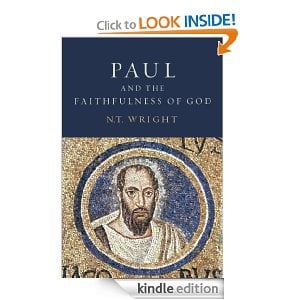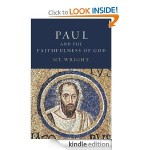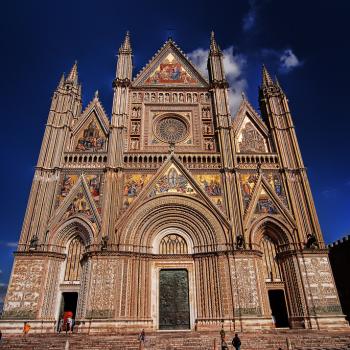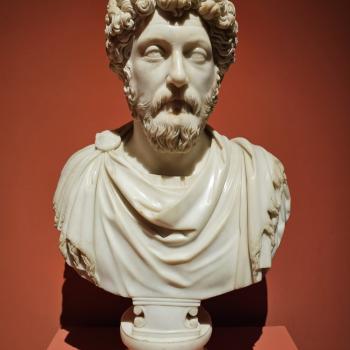Rehearsing a fair bit of the data Tom covered at length and well in Resurrection and the Son of God, Tom reminds us that the future hope of early Jews was basically not of an other-worldly nature. Very few texts (perhaps Wis. Sol. 3.1ff.) in fact take a non-material view of the afterlife. Thus Tom stresses that what answer you get from texts to a real extent depends on what questions you ask of a text— If you ask What must I do to inherit everlasting life? and mean by that what many modern Christians think that means, namely dying and going to be with God in heaven…. then you’ve asked the wrong question (see p. 163).
On p. 165, Tom throws down the gauntlet in this fashion….”At the risk of arousing thunderbolts of wrath and showers of angry meteorites, I venture to suggest that the scholarly construct of a ‘parousia’ in which the space-time universe would cease to exist, followed by a second order construct of a ‘delay’ in this event which then precipitates a new form of Christian self-consciousness, has been an enormous black hole in historical understanding into which legions of scholars have sucked one another through the gravitational forces of their unremitting zeal for ‘the traditions of the fathers’– the ‘fathers’ in this case being Schweitzer and Bultmann and their various successors.” As Tom says on p. 166, it is the worldviews rather than the language system which determine how the metaphors work, and in his view, cosmic language about the end of the world, is actually about the end of a world, and a particular worldview (so for example the language about the son turning black would be an apt metaphor for the eclipse of some ruler who claimed to be the sun god or Apollo for instance). Paul’s use of apocalyptic language does not support the notion that he anticipated the literal end of the space time continuum, is part of Tom’s point. But that is not nearly all, as Tom continues to follow George Caird’s (his doctor father at Oxford) reading of the eschatological language in early Jewish and Christian sources. He sees the material in Dan. 7,9 and 4 Ezra 11-12 to be about the victory of God’s people over the pagan empires of the world under the leadership of the Messiah (see p. 171).
The question as posed by Eddie Adams, Dale Allison and others who challenge some of Tom’s readings of apocalyptic material becomes which parts of these various dire predictions are to be seen as referring to actual future events and which parts are metaphorical coloring, as Tom calls it? In some ways I would say this is the wrong question. It’s not about sifting metaphor from potential future fact. The point is that all this metaphorical apocalyptic language is both metaphorical and referential. The proper question is– to what do these metaphors refer? Obviously we are not meant to take metaphors literally, but we are meant to take them seriously and referentially. The issue is not literal vs. metaphorical, because metaphors can be used to describe the real. The issue is referential vs. non-referential. For example, John Collins in his classic treatment ‘The Apocalyptic Imagination’ claims that apocalyptic language is not meant to be referential. It has some kind of emotive and consolatory force but it’s not real prophecy about real events, it’s not referential in that sense. I would strongly disagree. You could say a fair bit of early Jewish apocalyptic is referential and they simply got the predictions wrong. But I don’t think you can say it’s not referential. The question is— To what does it refer?
Does for example the language about Christ’s return on the clouds really refer to his ascension into heaven and ruling the world empire’s currently from above? This still allows the language to be referential but it turns future eschatology into inaugurated eschatology, something that Caird’s reading encourages us to consider. There is the further point that often cosmic upheaval metaphors are actually political in character referring to the collapse of literal empires, evil rulers etc. They don’t refer to the end of the space time continuum (see pp. 173-74). Tom adds that even when people saw literal earthquakes, comets etc. as referential to events soon to come to pass, they did not see them as referring to future earthquakes, comets etc. but rather to coming events in the social and political realm…. for example the ‘cosmic sign’ that was thought to augur the coming death of Julius Caesar, not a future cosmic sign on a grander scale.
To the question— ‘What is the solution to our current dilemma of having pagan overlords’ Tom says Pharisaic Jews saw as the solution to the smaller scale problem that Jews become more rigorous in keeping the Torah, and pray hard for God to fulfill his promises, and perhaps in some cases join the freedom fighters against the overlords, and perhaps the new age is dawning through more rigorous observance of the law etc. (see pp. 178-79). In part this was based on the Pharisaic synergistic approach to life. Unlike the Essenes who thought one should just wait for divine intervention (being deterministic in theology) or the Sadducees who simply believed in free will and doing what they wanted, the Pharisees believed “they were required to work towards bringing God’s kingdom, even though in the end it was up to God himself how and when he would do it” (p. 181). Tom stresses their creational monotheism. Salvation never looked merely like the abandonment of the space time continuum for an ethereal other world realm called heaven. It looked like the election by God of a people,rescuing them from bondage, and it involved future resurrection as well. Tom suggests (p. 182) that the moral dilemma facing the Pharisees was that while they believed God’s people were meant to be the solution to the world’s battle with evil, and yet they themselves kept being engulfed by that evil, how then could Israel fulfill its role as a light to the nations? Early Christians saw Jesus as the answer to the question– he was the elect one, the true Israelite, the light of the world, who fulfilled Israel’s roll to both God’s people and to the world. God’s people, the whole of humanity, and creation itself must be put right as God is not interested in just redeeming human souls, or even in just rescuing his own people, but restoring the whole of his creation.
P. 187 provides an important summary of how Tom things Saul the Pharisee would have viewed things before he became a follower of Christ, namely: 1) in the age to come God will judge the wicked (both pagans and renegade Jews), and will vindicate (=declare righteous) his people (i.e. will declare that they are part of the all Israel); 2) the present marks of this vindicated/justified people will be the things that show their loyalty to their God and their zeal for his covenant, and 3) this entails especially the keeping of the things that distinguish Jews from Gentiles— sabbath, food laws, circumcision, and 4) those who do these things are marked out as those who in the future will be vindicated as true Jews. In other words, “the doctrine of justification [has] as it nest the interface between election and eschatology” (p. 188). In an interesting footnote, Tom talks about the phrase the glory of Adam in the Qumran lit. (1 QS 4.23, CD 3.20 and other references on p. 189 n.434), which refers to the inheritance of Adam, restored to God’s people who keep Torah. Glory in such texts does not equal sovereignty. “The glory of Adam seems to include the dominion, the stewardship exercised by Adam over all God’s creation” (p. 190). At the end of this lengthy discussion Tom concludes that Paul’s missionary zeal to convert others does not likely have a precursor in his having evangelized Gentiles as a Pharisee, it comes from another source. His prior concern was with dealing with those he deemed renegade Jews, like Stephen.
—-
In response to a request for Tom to clarify exactly what he thinks is still outstanding when it comes to eschatological events, he says the following in an email to me…
“I’m puzzled because I have constantly, regularly, explicitly and directly affirmed all the above– the 2nd coming, the future resurrection, the final judgment the new heaven and new earth. George Caird did too. It would be quite bizarre for Allison or Adams or anyone else to suggest, in view of the entire argument of The Resurrection of the Son of God, and especially Surprised by Hope, to suppose that I have a fully realized eschatology (like those oddballs who think that the entire end-time events happened in AD 70!). The great events in Romans 8.18-26, for a start, clearly haven’t happened yet; ditto 1 Cor 15, Phil 3.20f., etc etc. It would be absurd (or very depressing) to think otherwise. My reading of Allison is that HE has a totally UNDER-realized eschatology, a kind of gloomy nothing’s-really-happened-yet view… which may go with his (non?)-view of Jesus’ bodily resurrection??
If I had to state what I think is still to come I would simply summarize the middle chapters of Surprised by Hope. New creation (the complete renewal of the entire created order, heaven and earth coming together at last, corruption and decay and death abolished for ever); Jesus himself the personally present centrepiece and sovereign over all of it, finally revealed/returned (the two amount to the same thing from the perspective of the new world, as is signalled in e.g. 1 Jn 3.1f., Col 3.1-4); the final sorting-out/putting-right of all things, as in the Psalms (96, 98, etc); the resurrection of the dead. All of these belong very closely together with one another, and all are predicated (a) on the ancient Jewish beliefs in the one God as creator and judge and (b) on the death and resurrection of Jesus himself . . .”














